Benchmark Effects of Leadership Styles Health Care

For this assignment, explore the different types of leadership styles. In a 10-12-slide PowerPoint discuss which approaches are most effective for a health care setting and why. For the presentation of your PowerPoint, use Loom to create a voice-over or a video. Refer to the Topic Materials for additional guidance on recording your presentation with Loom. Include an additional slide for the following: Title page, Loom link (at the beginning), and an additional slide for References at the end.
- Define leadership style and explain why it is important to for health care leaders to understand their leadership style.
- Outline the leadership skills and behaviors necessary to leverage diversity, foster inclusion and ensure professionalism and professional responsibility.
- Examine different leadership styles. Describe two leadership styles that would be especially effective in a health care setting and explain why. Discuss advantages and challenges for each of these leadership styles.
- Explain how leadership styles are impacted by personal, organizational, societal, multicultural, and global norms and values.
A minimum of three academic references from credible sources are required for this assignment.
While APA style is not required for the body of this assignment, solid academic writing is expected, and documentation of sources should be presented using APA formatting guidelines, which can be found in the APA Style Guide, located in the Student Success Center.
This assignment uses a rubric. Please review the rubric prior to beginning the assignment to become familiar with the expectations for successful completion.
You are required to submit this assignment to LopesWrite. Refer to the LopesWrite Technical Support articles for assistance.
Expert Answer and Explanation
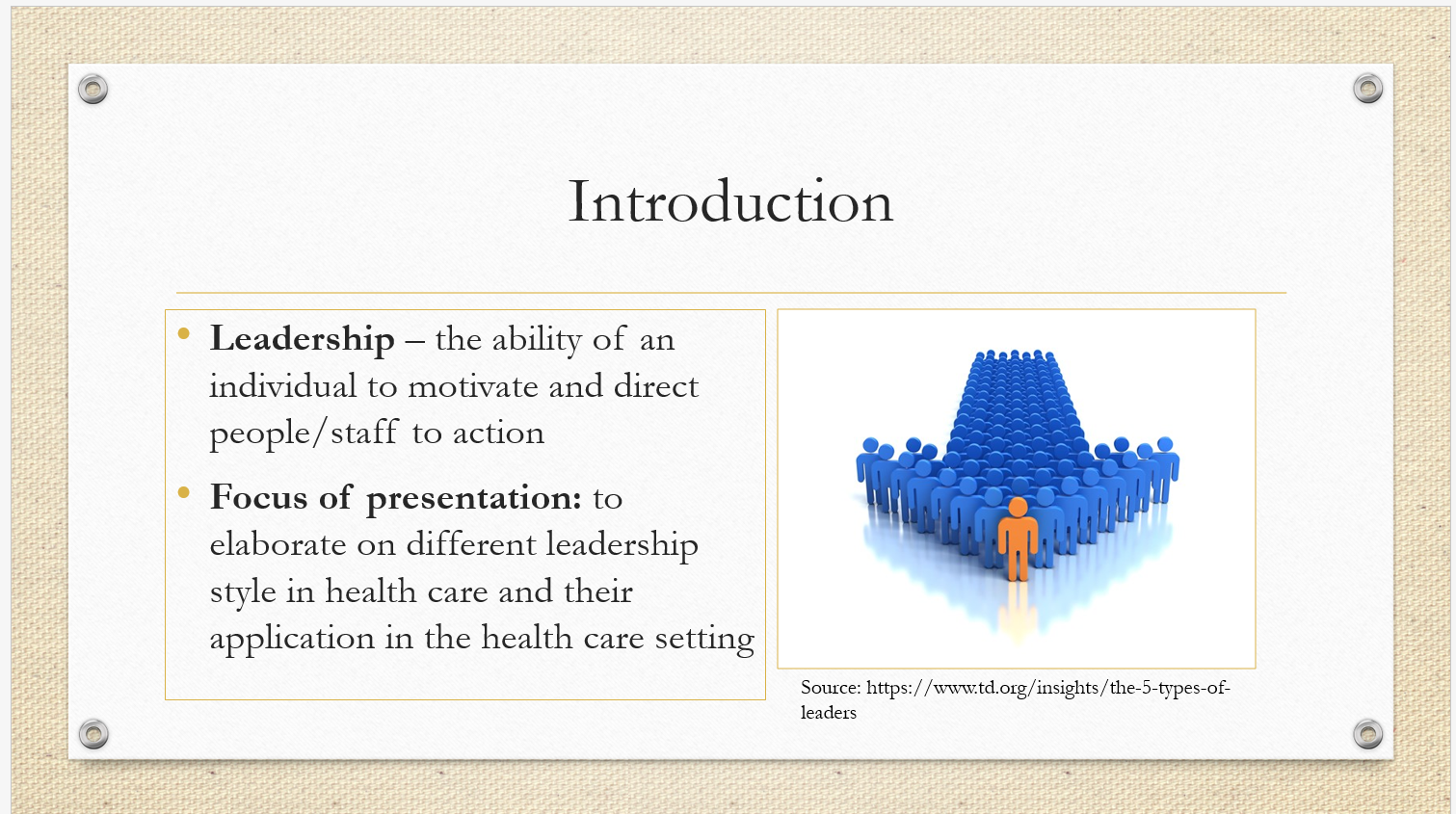
Leadership: is the ability of an individual to motivate and direct people/staff to action. It is an essential component in dictating individual and organizational performance (Sfantou et al., 2017). The purpose of this presentation is to elaborate on different leadership style in health care and their application in the health care setting.
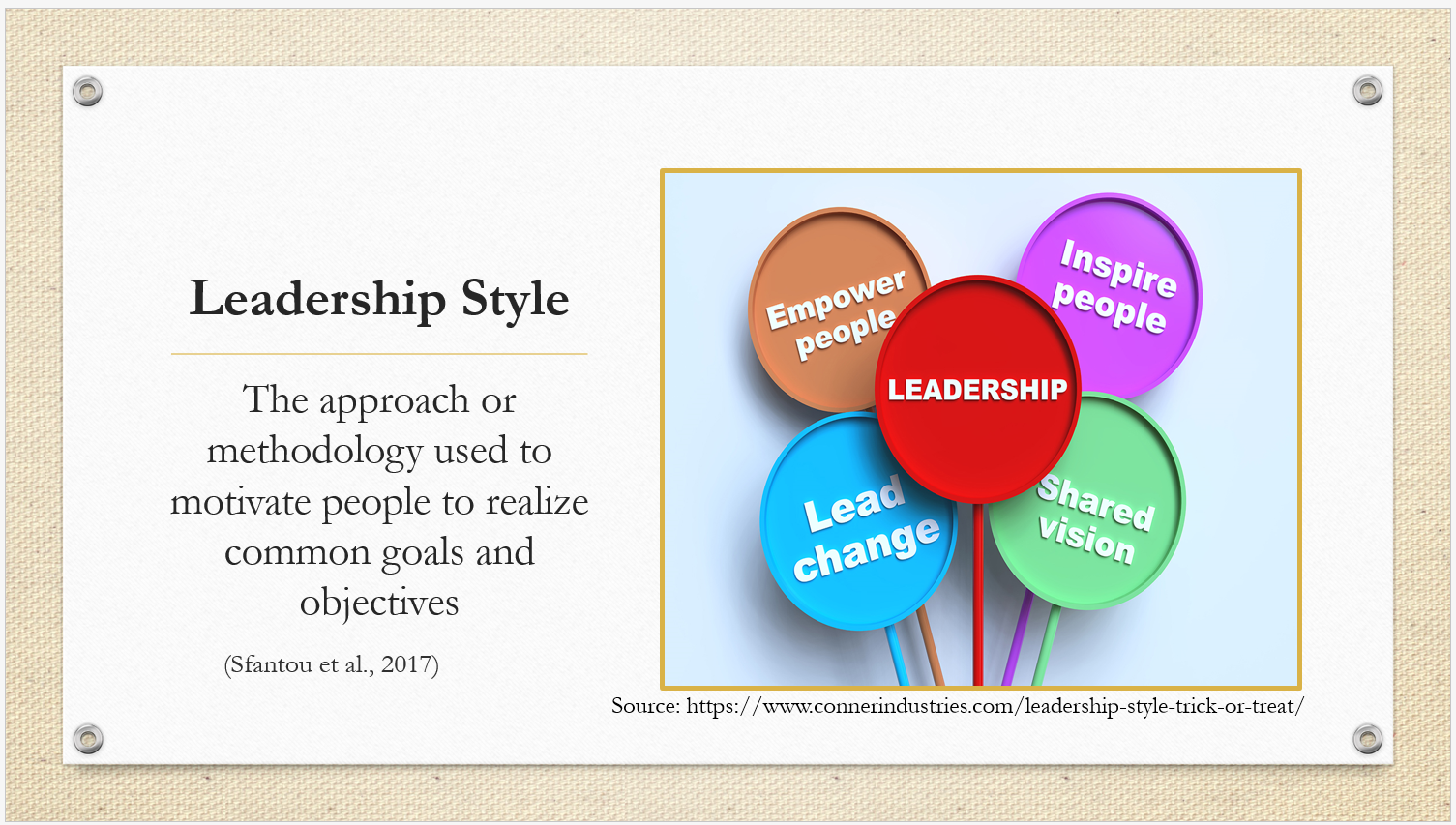
Leadership style entails the approach or methodology used to motivate people to realize common goals and objectives (Sfantou et al., 2017). There are different leadership styles as will be discussed later in this presentation.
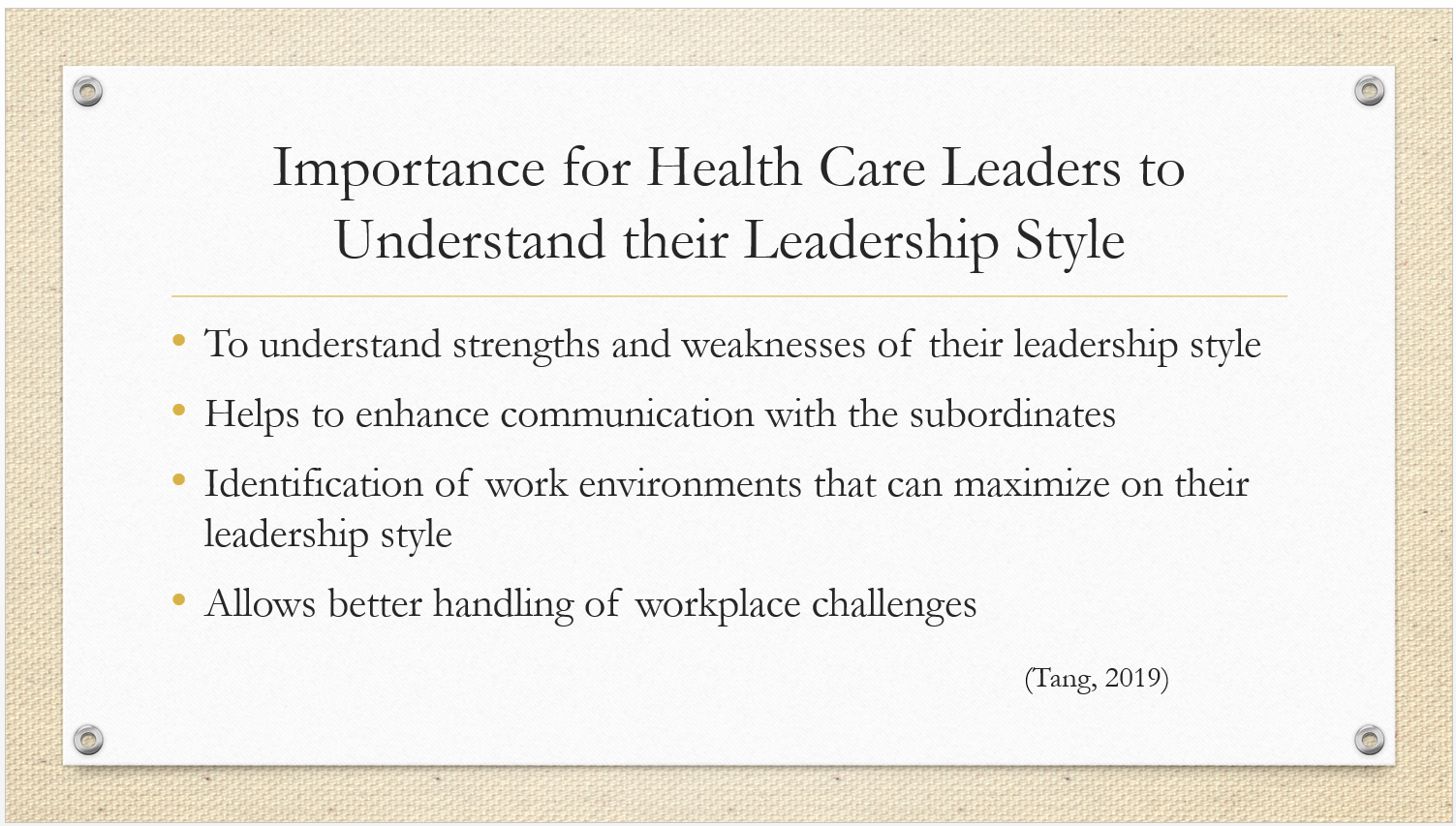
Understanding leadership styles for health care leaders is important. The first importance is that is allows leaders to understand their strengths and weaknesses characterized by their leadership style. With this information they can maximize on their strengths and work on their weakness to make them even more effective in leading.
Another importance of knowing personal leadership style is that it helps leaders to understand ways how they can enhance communication with their subordinates (Tang, 2019). Understanding one’s leadership style is also important in identifying work environments where a leader can maximize the potential of the subordinates under them. Lastly, understanding leadership style is important in helping the leader have better control of their workplace challenges (Tang, 2019).
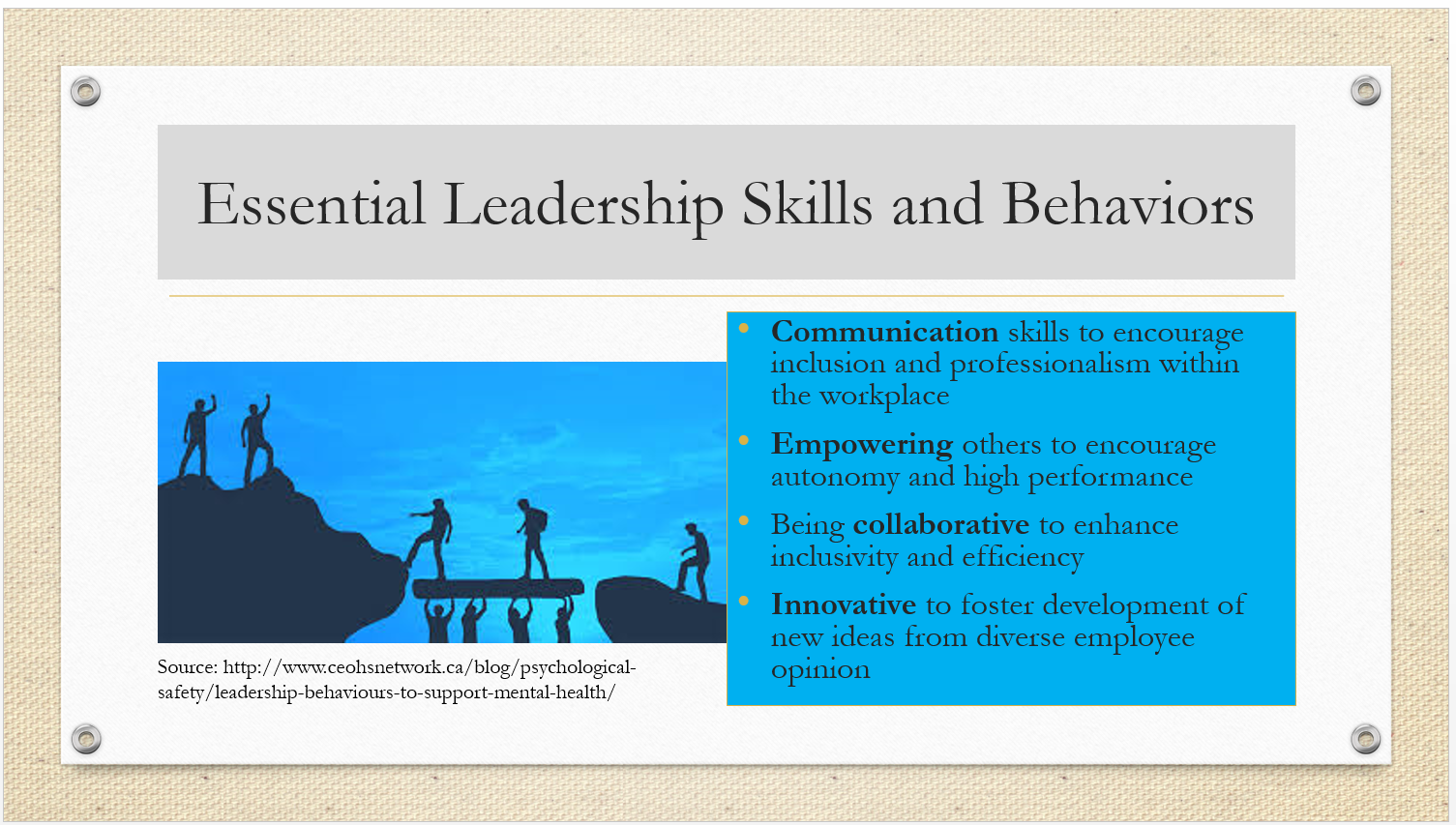
Some of the leadership skills and behaviors required from a leader include the following.
Communication skills to encourage inclusion and professionalism within the workplace (Pidgeon, 2017)
Empowering others to encourage autonomy and high performance
Being collaborative to enhance inclusivity and efficiency
Innovative to foster development of new ideas from diverse employee opinion
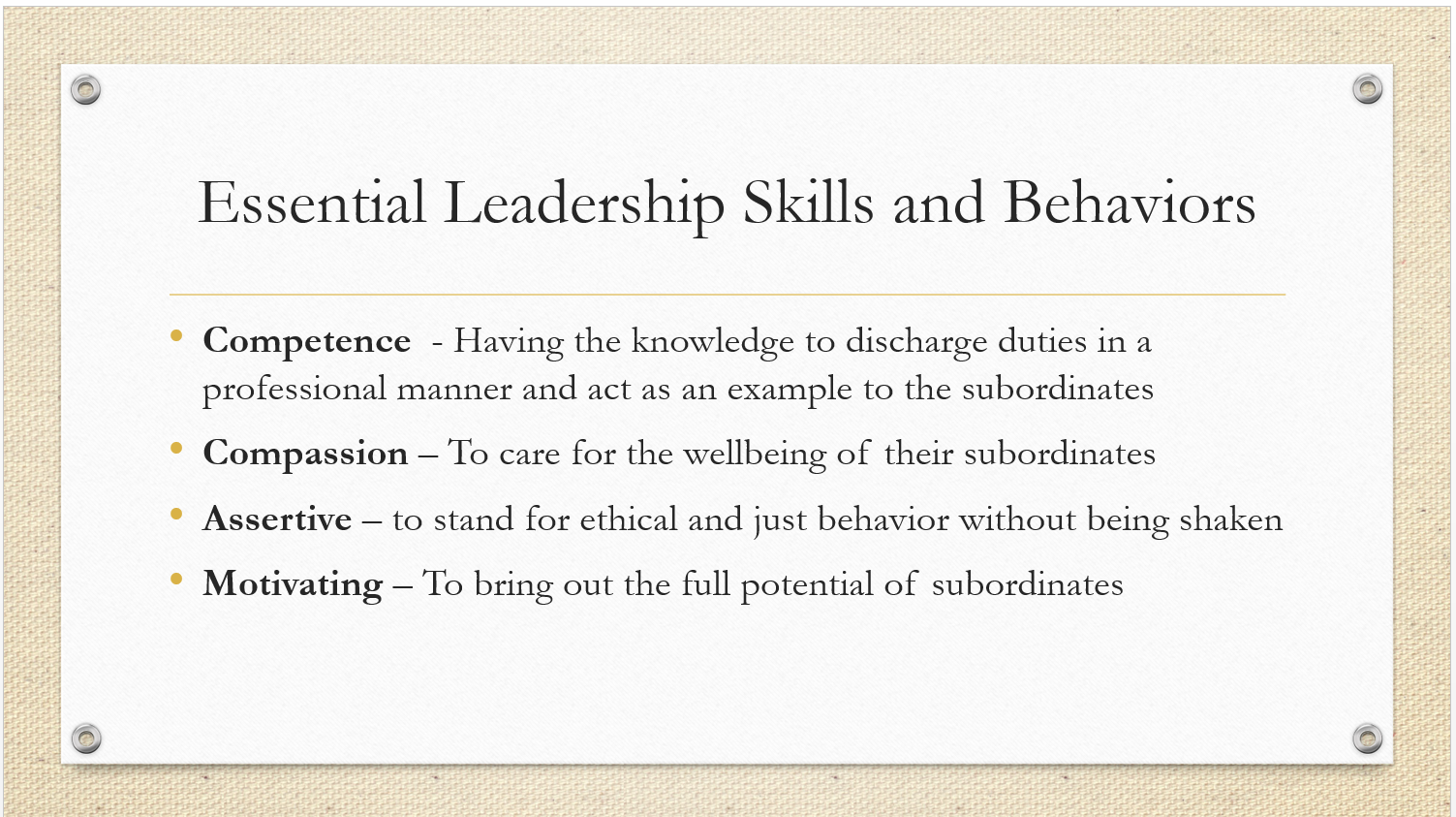
Other behaviors and skills essential to leverage diversity, foster inclusion and ensure professionalism and professional responsibility include;
Competence – Having the knowledge to discharge duties in a professional manner and act as an example to the subordinates (Pidgeon, 2017)
Compassion – To care for the wellbeing of their subordinates
Assertive – to stand for ethical and just behavior without being shaken
Motivating – To bring out the full potential of subordinates (Pidgeon, 2017)
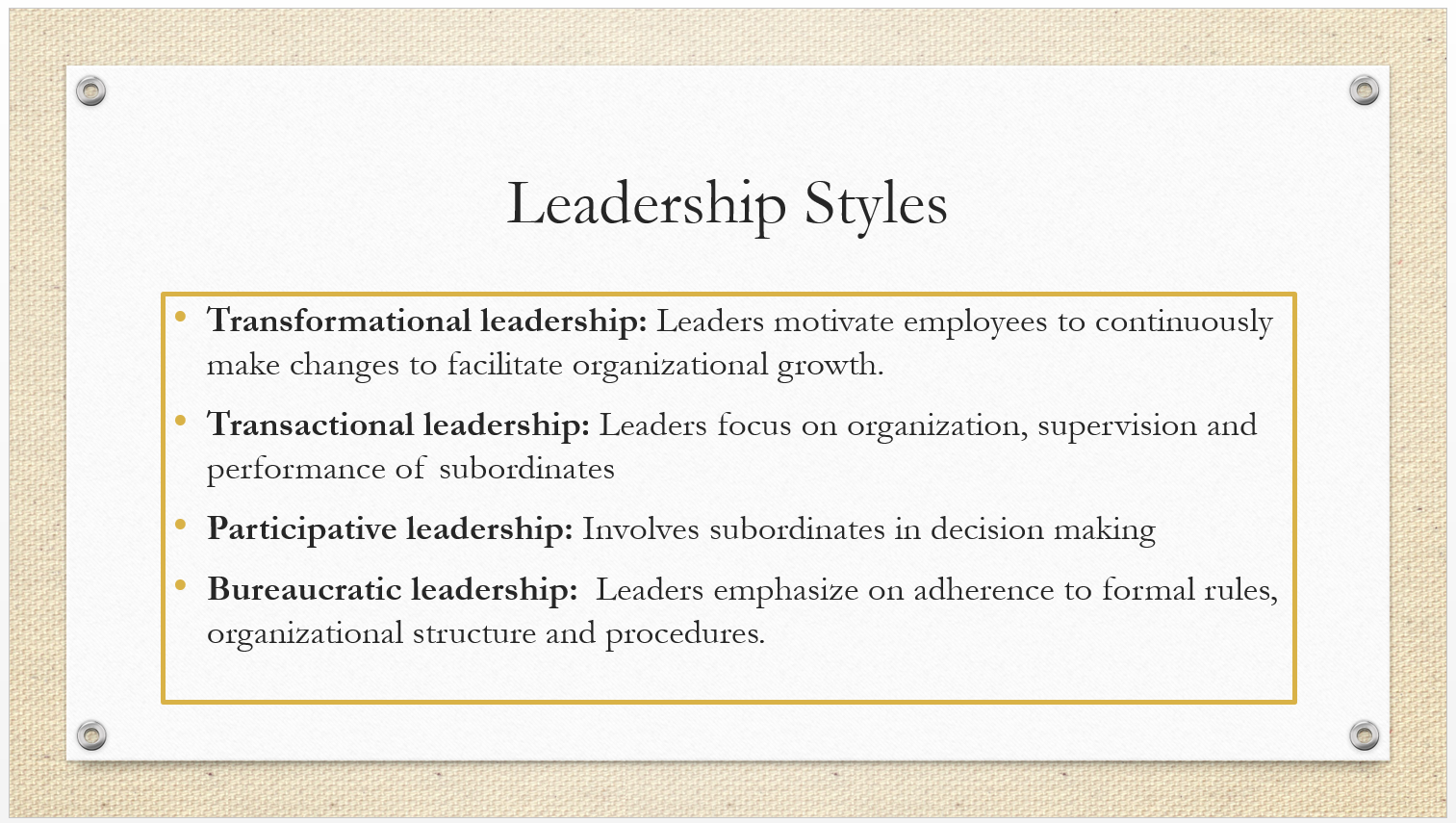
There are several styles of leadership; some of them include
- Transformational leadership: This is a leadership style where leaders motivate employees to continuously make changes to facilitate organizational growth (Gandolfi & Stone, 2018)
- Transactional leadership: This is a leadership style that focuses on organization, supervision and performance of employees as key drivers to organizational growth (Gandolfi & Stone, 2018)
- Participative leadership: just like democratic leadership, this is a type of leadership that encourages the involvement of subordinates in decision making (Xu, 2017).
- Bureaucratic leadership: this is a type of organizational leadership which emphasizes on adherence to formal rules, organizational structure and procedures.
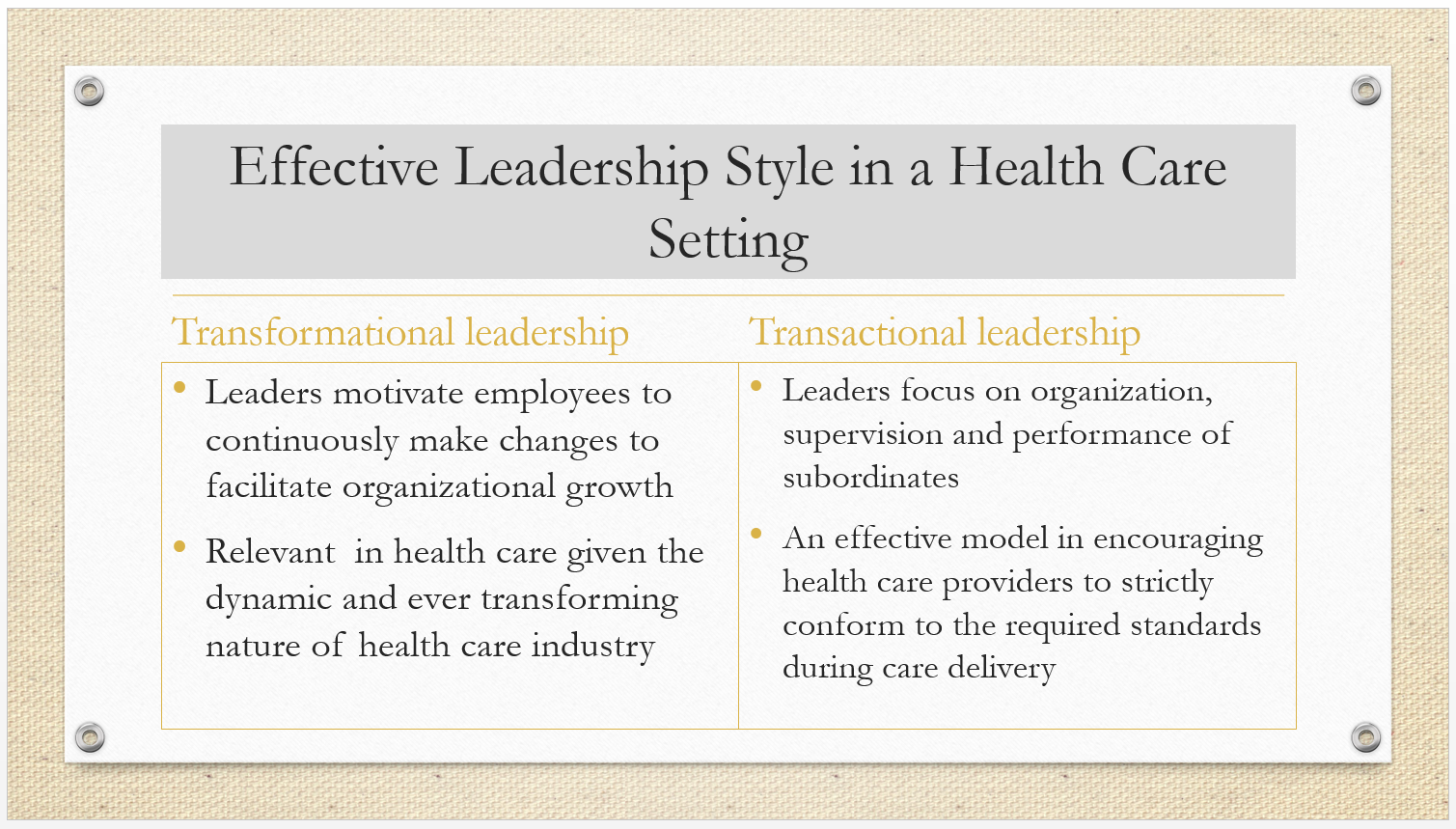
The two selected types of leadership that would be relevant in health care include transformational and transactional leadership styles.
As explained earlier, transformational leadership is a leadership style where leaders motivate employees to continuously make changes to facilitate organizational growth (Gandolfi & Stone, 2018). This leadership style embraces a system of continuous improvement and organizational growth. It is relevant in health care given the dynamic and ever transforming nature of health care industry
Transactional leadership is a leadership style that focuses on organization, supervision and performance of employees as key drivers to organizational growth (Gandolfi & Stone, 2018). This form leadership is relevant in health care, given the emphasis on quality and ethical practice required in patient care. using transactional leadership, leaders will encourage their subordinates to strictly conform to the required standards when delivering care to patients.
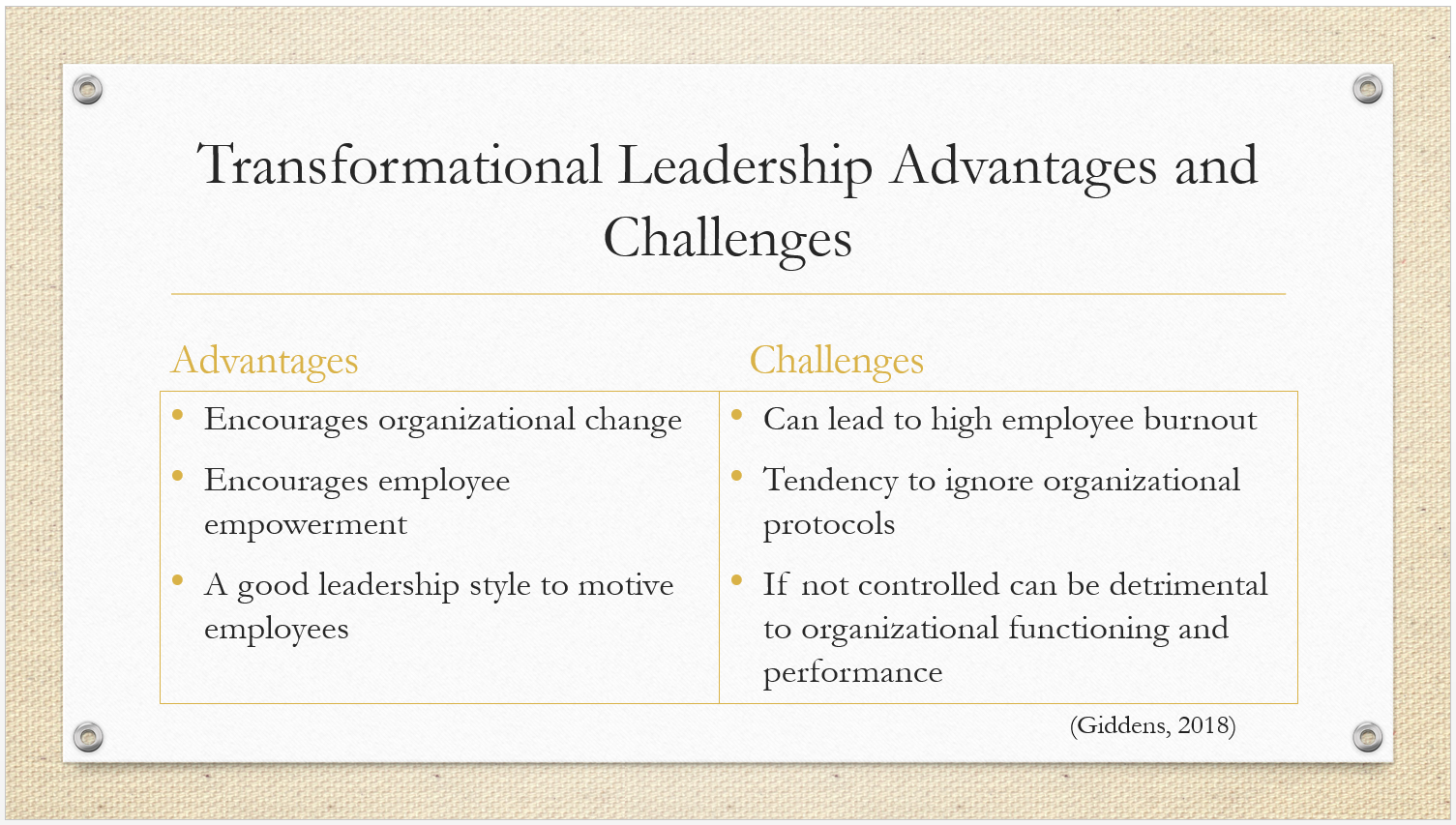
Transformational leadership has various advantages. The first advantage is that it encourages organizational change making the organization be more flexible to any changes within or outside the organization. This leadership style also encourages individual employee empowerment, continuous learning, and growth (Giddens, 2018). Transformational leadership is also characterized in most cases with high employee motivation.
Some of the challenges associated with this type of leadership include high employee burnout when the expectations are set too high (Giddens, 2018). Another challenge is that it has a tendency to ignore organizational protocols especially when trying to encourage organizational change and transformation. The last challenge is that if not controlled, this leadership style can, be detrimental to organizational functioning and performance when the intended change or transformation goes contrary to the plans.
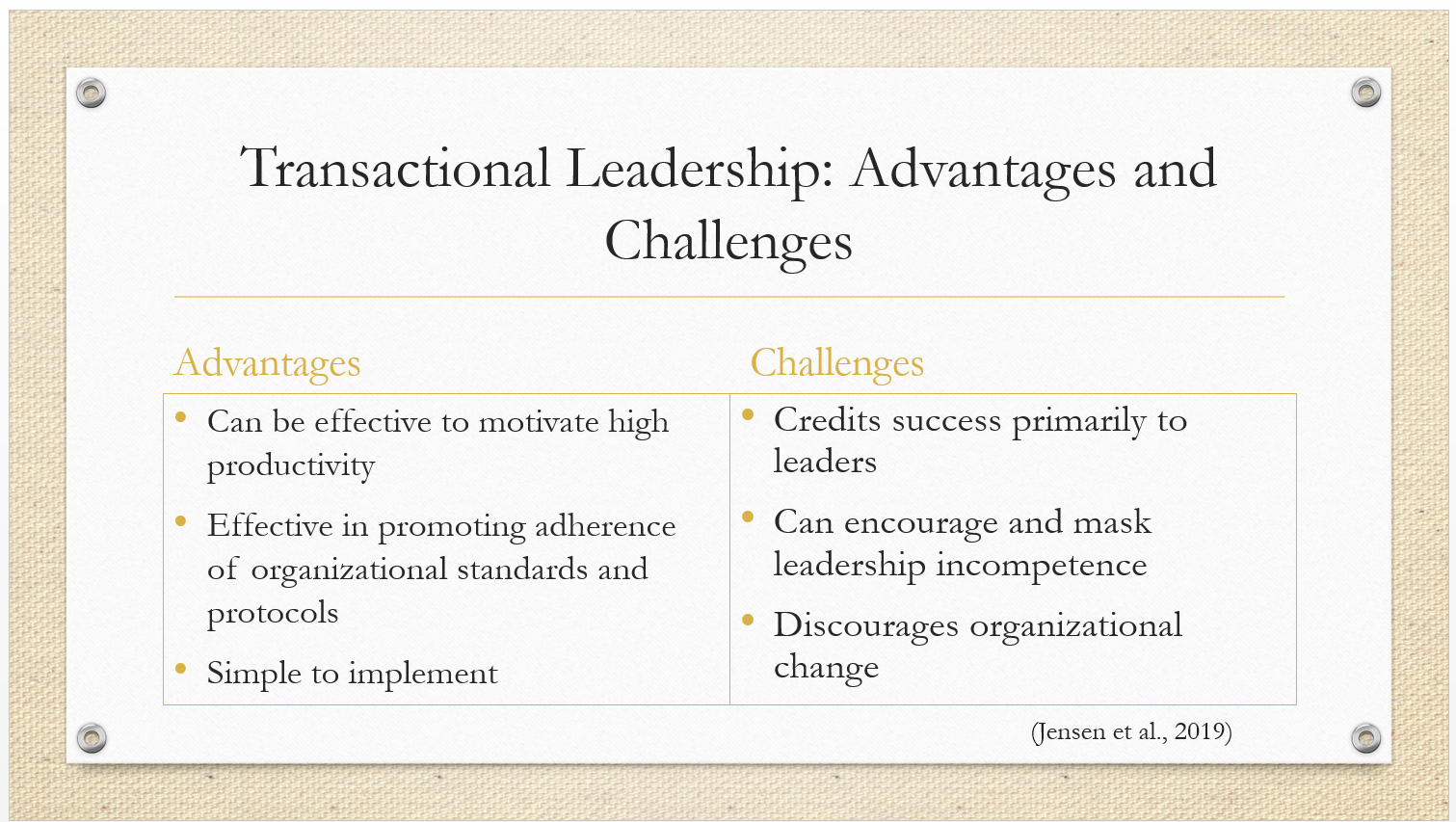
Transactional leadership has the following advantages, the first advantage is that it is an effective approach in motivating high employee productivity, given its emphasis on reward system (Jensen et al., 2019). This leadership style is also effective in promoting adherence of organizational standards and protocols. Transactional leadership style is also simple to implement in comparison to other forms of leadership.
Some of the challenges with this leadership style include;
Discourages organizational change and supports maintenance of status quo. It credits most of the success to the leadership (Jensen et al., 2019). Transactional leadership style can also mask incompetence from leaders making leadership incompetence difficult to counter

Leadership style is a variable influenced by personal, organizational, societal, multicultural, and global norms and values. Some of the ways leadership is influenced by these factors include in decision-making. Depending on the norms and values ascribed to by a leader, they will be inclined to make decisions in a certain way which will end up determining their style of leadership.
Another way leadership is impacted is in communication, where a leader will likely develop communication modes based on a given set of values. The last, is the ability to influence. Given the norms or values held by an individual, they are likely to relate and communicate with people differently which impacts their ability to influence others.
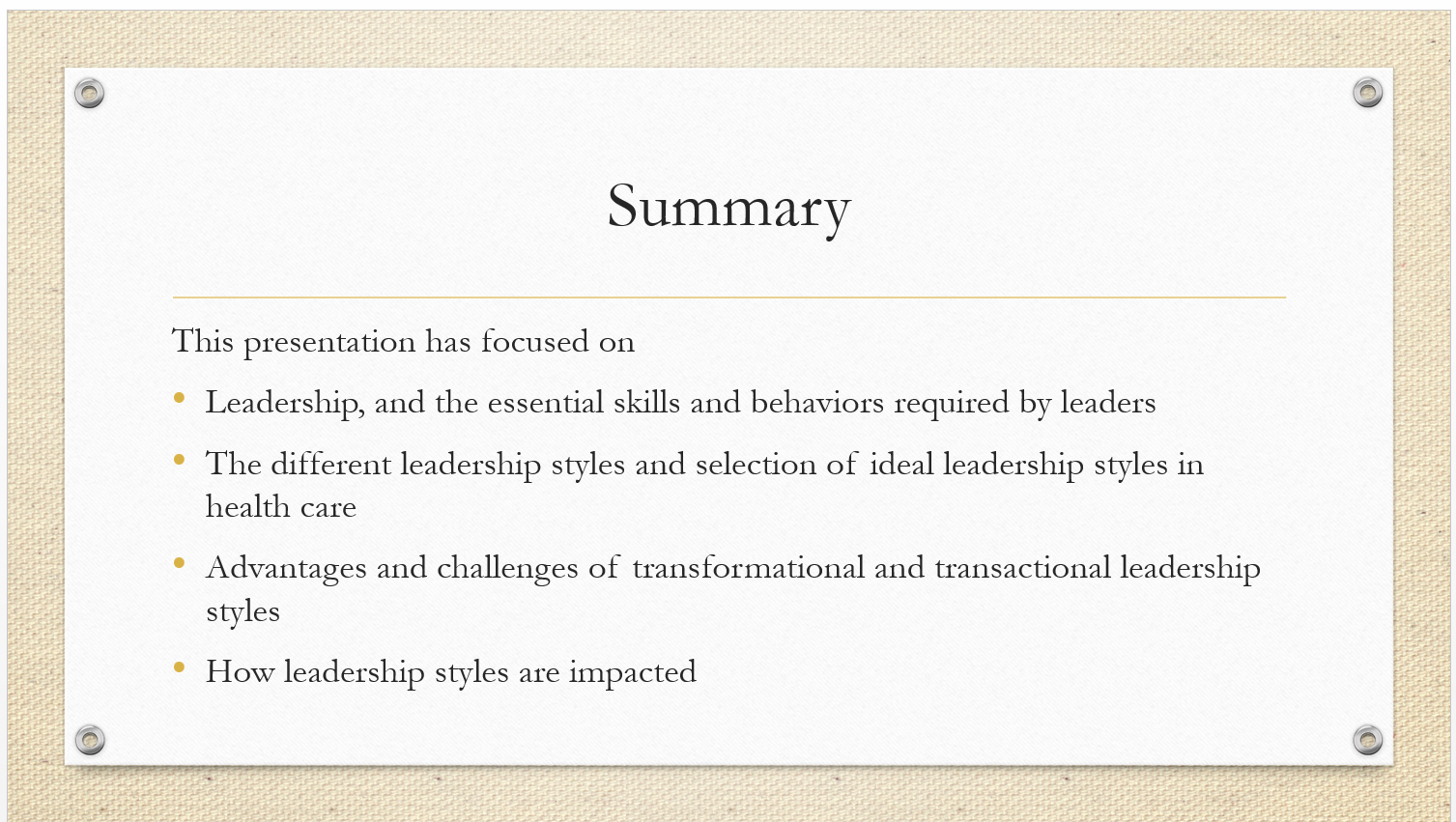
References
- Gandolfi, F., & Stone, S. (2018). Leadership, leadership styles, and servant leadership. Journal of Management Research, 18(4), 261-269.
- Giddens, J. (2018). Transformational leadership: What every nursing dean should know. Journal of Professional Nursing, 34(2), 117-121. https://doi.org/10.1016/j.profnurs.2017.10.004
- Jensen, U. T., Andersen, L. B., Bro, L. L., Bøllingtoft, A., Eriksen, T. L. M., Holten, A. L., … & Würtz, A. (2019). Conceptualizing and measuring transformational and transactional leadership. Administration & Society, 51(1), 3-33.
- Pidgeon, K. (2017). The keys for success: Leadership core competencies. Journal of Trauma Nursing| JTN, 24(6), 338-341.
- Sfantou, D. F., Laliotis, A., Patelarou, A. E., Sifaki-Pistolla, D., Matalliotakis, M., & Patelarou, E. (2017). Importance of Leadership Style towards Quality of Care Measures in Healthcare Settings: A Systematic Review. Healthcare (Basel, Switzerland), 5(4), 73. https://doi.org/10.3390/healthcare5040073
- Tang, K. N. (2019). Leadership styles and organizational effectiveness. In Leadership and change management(pp. 11-25). Springer, Singapore.
- Xu, J. H. (2017). Leadership theory in clinical practice. Chinese Nursing Research, 4(4), 155-157. https://doi.org/10.1016/j.cnre.2017.10.001
Place your order now for a similar assignment and get fast, cheap and best quality work written by our expert level assignment writers. Use Coupon: NEW30 to Get 30% OFF Your First Order
Use Coupon: NEW30 to Get 30% OFF Your First Order

Answered Questions:
ANSWERED!! Assume you are a nurse manager on a unit
ANSWERED!! Watch the Diary of Medical Mission Trip
ANSWERED!! Re-read Take a Closer Look: Exploring Claude
ANSWERED!! Develop and submit a personal leadership
ANSWERED!! Develop and submit a personal leadership
ANSWERED!! Mrs. Adams a 68-year-old widow who was
ANSWERED!! Planning is the key to successful completion
SOLVED! Design a list of 10 data elements related to the
SOLVED! Four spheres of political action in nursing
SOLVED! Case C 38-year-old Native American pregnant
SOLVED! Patient AO has a history of obesity and has recently
SOLVED! Case 3-1 You Can’t Get There From Here
FAQs
What are leadership styles in healthcare?/leadership styles used in healthcare/what are the different leadership styles in healthcare?/most common leadership styles in healthcare/types of leadership styles in healthcare/
There are several different leadership styles that can be effective in healthcare settings. Here are some examples:
- Transformational leadership: Transformational leaders inspire and motivate their team to achieve their best potential. They focus on developing their staff, promoting innovation and creativity, and building a positive organizational culture.
- Servant leadership: Servant leaders prioritize the needs of their team and patients over their own interests. They focus on serving others and empowering their team to achieve their goals.
- Transactional leadership: Transactional leaders focus on providing clear expectations, rewards, and consequences to their team. They provide specific goals and objectives and hold their team accountable for meeting them.
- Autocratic leadership: Autocratic leaders make decisions on their own without input from their team. They use their power and authority to control their team and maintain a strict hierarchy.
- Laissez-faire leadership: Laissez-faire leaders delegate tasks and responsibilities to their team and provide minimal guidance or direction. They give their team a lot of freedom to make decisions and solve problems on their own.
Benefits of leadership in healthcare
Effective leadership in healthcare can bring numerous benefits to organizations, staff, and patients. Here are some of the key benefits:
- Improved Patient Outcomes: Effective leaders in healthcare can inspire their team to provide high-quality care to patients. They can develop a culture of excellence and encourage staff to continuously improve their skills and knowledge. This can result in better patient outcomes, including reduced morbidity and mortality rates, improved patient satisfaction, and better patient experiences.
- Increased Staff Engagement: Good leaders can create a positive work environment where staff feel valued, motivated, and engaged. This can lead to better retention rates, reduced absenteeism and burnout, and increased job satisfaction. When staff are engaged, they are more likely to provide high-quality care, communicate effectively, and work collaboratively with their colleagues.
- Better Financial Performance: Effective leadership can also improve the financial performance of healthcare organizations. Good leaders can identify and implement cost-saving measures, increase efficiency, and optimize resource utilization. They can also create a culture of accountability and transparency, which can lead to improved financial reporting and better decision-making.
- Enhanced Collaboration: Effective leaders can foster a culture of collaboration and teamwork among healthcare professionals. They can encourage communication and information sharing, and promote a shared vision and goals. This can result in improved coordination of care, reduced medical errors, and better patient outcomes.
- Innovation and Creativity: Effective leaders in healthcare can encourage innovation and creativity among their staff. They can create an environment where new ideas are welcomed and encouraged, and where staff feel empowered to try new things. This can lead to the development of new treatments, processes, and technologies that can improve patient care and outcomes.
How can leaders promote diversity?
Promoting diversity is an important responsibility of leaders in healthcare, as it can lead to a more inclusive and equitable workplace that better serves the needs of patients and the community. Here are some ways that leaders can promote diversity:
- Build a diverse team: One of the most effective ways to promote diversity is to build a diverse team. Leaders should actively seek out and recruit staff from diverse backgrounds, including different races, ethnicities, genders, religions, and sexual orientations. This can be done through targeted outreach efforts, partnerships with community organizations, and inclusive job postings.
- Provide training and education: Leaders should provide training and education to staff on topics related to diversity, equity, and inclusion. This can include implicit bias training, cultural competence training, and diversity awareness training. These trainings can help staff understand and appreciate the perspectives and experiences of others and improve their ability to work effectively in diverse teams.
- Foster an inclusive culture: Leaders should foster a culture of inclusion and respect where all staff feel valued and supported. This can be done through policies and practices that promote diversity and equity, such as flexible work arrangements, equal pay for equal work, and employee resource groups. Leaders should also model inclusive behavior and hold staff accountable for creating a welcoming and respectful workplace.
- Engage with the community: Leaders should engage with the local community to better understand their needs and perspectives. They should partner with community organizations and hold events to promote diversity and inclusivity. This can help build trust and rapport with the community and improve the organization’s ability to provide culturally responsive care.
- Evaluate and improve diversity efforts: Leaders should regularly evaluate their diversity efforts and identify areas for improvement. They should collect and analyze data on staff diversity, patient demographics, and outcomes to identify disparities and develop targeted interventions. This can help ensure that the organization is making progress towards its diversity goals and that staff and patients are benefiting from these efforts.
Define the three types of diversity and compare them using examples for each type
The three types of diversity are demographic diversity, cognitive diversity, and experiential diversity.
- Demographic diversity: This refers to differences among people based on their characteristics such as age, gender, race, ethnicity, sexual orientation, and socioeconomic status. Demographic diversity is important because it can bring different perspectives, experiences, and ideas to the table.
Example: A team that consists of people from diverse backgrounds, such as a mix of gender, race, ethnicity, and socioeconomic status, can bring different perspectives to a problem. For instance, a group of individuals from diverse backgrounds working on a project related to public health can bring unique insights based on their personal experiences and cultural backgrounds.
- Cognitive diversity: This refers to differences in the way people think, process information, and solve problems. It involves different approaches to decision-making, creativity, and problem-solving.
Example: A team that consists of individuals with different thinking styles, such as analytical, intuitive, and practical, can generate more diverse ideas and solutions. For instance, a group of individuals with different thinking styles working on a marketing campaign can bring a variety of ideas that cater to different segments of the audience.
- Experiential diversity: This refers to differences in people’s work experiences, education, and career backgrounds. It involves individuals with diverse skill sets, expertise, and knowledge.
Example: A team that consists of individuals with different professional backgrounds, such as engineers, marketers, and designers, can bring diverse expertise to a project. For instance, a group of individuals with diverse backgrounds working on a software development project can bring diverse skills to the table, such as coding, user interface design, and database management.
The importance of diversity in leadership
Diversity in leadership is crucial for several reasons:
- Diverse perspectives: When leaders come from different backgrounds and experiences, they can bring a wider range of perspectives and insights to their decision-making. This can lead to more creative solutions and better problem-solving.
- Improved decision-making: Diverse leaders can challenge each other’s assumptions and biases, leading to more thorough and well-rounded decision-making. This can help to avoid groupthink and make better decisions for the organization.
- Representation: Diverse leadership can help to ensure that different voices and perspectives are represented within an organization. This can lead to a more inclusive and equitable workplace culture.
- Better communication: Leaders who have experience working with diverse teams can communicate more effectively with employees from different backgrounds. This can help to build trust, foster collaboration, and create a more cohesive team.
- Improved performance: Studies have shown that diverse teams and organizations tend to perform better than homogenous ones. This can lead to increased innovation, higher employee engagement, and better financial performance.
Examples of diverse leaders
Here are some examples of diverse leaders from different fields and backgrounds:
- Kamala Harris: She is the first woman, first Black person, and first person of Indian descent to hold the office of Vice President of the United States.
- Satya Nadella: He is the CEO of Microsoft and is of Indian descent. Nadella has been recognized for his commitment to diversity and inclusion in the workplace.
- Rosalind Brewer: She is the CEO of Walgreens Boots Alliance and the first Black woman to lead a Fortune 500 company.
- Tim Cook: He is the CEO of Apple and the first openly gay CEO of a Fortune 500 company. Cook has been a vocal advocate for LGBTQ+ rights and has prioritized diversity and inclusion at Apple.
- Angela Merkel: She is the Chancellor of Germany and the first woman to hold the office. Merkel has been a strong advocate for gender equality and has promoted diversity and inclusion in German politics.
- Mellody Hobson: She is the co-CEO of Ariel Investments, a prominent Black-owned investment firm. Hobson is also a board member of several major corporations and has been a vocal advocate for diversity and inclusion in the workplace.

I am a professional nursing assignment expert offering comprehensive academic support to university nursing students across various institutions. My services are designed to help learners manage their workload effectively while maintaining academic excellence. With years of experience in nursing research, case study writing, and evidence-based reporting, I ensure every paper is original, well-researched, and aligned with current academic standards.
My goal is to provide dependable academic assistance that enables students to focus on practical training and career growth.
Contact me today to receive expert guidance and timely, high-quality nursing assignment help tailored to your academic needs.

